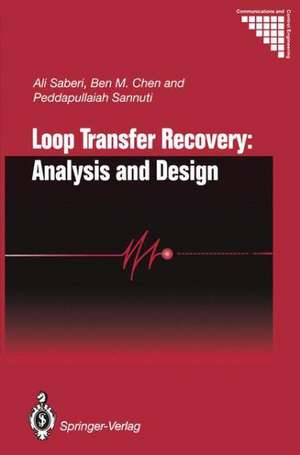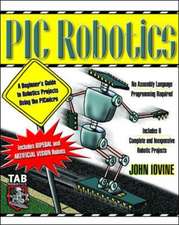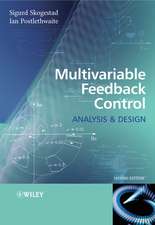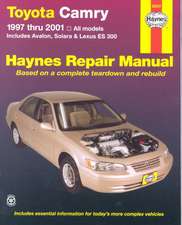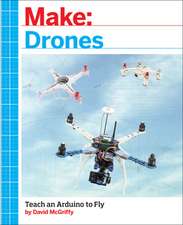Loop Transfer Recovery: Analysis and Design: Communications and Control Engineering
Autor Ali Saberi, Ben M. Chen, Peddapullaiah Sannutien Limba Engleză Paperback – dec 2011
Din seria Communications and Control Engineering
- 15%
 Preț: 659.70 lei
Preț: 659.70 lei - 20%
 Preț: 879.74 lei
Preț: 879.74 lei - 18%
 Preț: 953.65 lei
Preț: 953.65 lei - 18%
 Preț: 1117.03 lei
Preț: 1117.03 lei - 9%
 Preț: 1385.77 lei
Preț: 1385.77 lei - 18%
 Preț: 1128.08 lei
Preț: 1128.08 lei - 18%
 Preț: 953.65 lei
Preț: 953.65 lei - 15%
 Preț: 656.89 lei
Preț: 656.89 lei - 18%
 Preț: 896.52 lei
Preț: 896.52 lei - 18%
 Preț: 1113.26 lei
Preț: 1113.26 lei - 18%
 Preț: 1388.22 lei
Preț: 1388.22 lei - 15%
 Preț: 647.27 lei
Preț: 647.27 lei - 18%
 Preț: 954.45 lei
Preț: 954.45 lei - 18%
 Preț: 1231.47 lei
Preț: 1231.47 lei - 18%
 Preț: 948.92 lei
Preț: 948.92 lei - 18%
 Preț: 1232.57 lei
Preț: 1232.57 lei - 18%
 Preț: 1127.28 lei
Preț: 1127.28 lei - 15%
 Preț: 643.34 lei
Preț: 643.34 lei - 18%
 Preț: 1401.30 lei
Preț: 1401.30 lei - 15%
 Preț: 651.51 lei
Preț: 651.51 lei - 20%
 Preț: 1454.07 lei
Preț: 1454.07 lei - 18%
 Preț: 948.79 lei
Preț: 948.79 lei - 18%
 Preț: 1233.06 lei
Preț: 1233.06 lei - 18%
 Preț: 947.85 lei
Preț: 947.85 lei - 18%
 Preț: 950.96 lei
Preț: 950.96 lei - 18%
 Preț: 956.99 lei
Preț: 956.99 lei - 15%
 Preț: 644.18 lei
Preț: 644.18 lei - 18%
 Preț: 946.87 lei
Preț: 946.87 lei - 18%
 Preț: 951.14 lei
Preț: 951.14 lei - 18%
 Preț: 961.55 lei
Preț: 961.55 lei - 15%
 Preț: 644.18 lei
Preț: 644.18 lei - 20%
 Preț: 990.80 lei
Preț: 990.80 lei - 18%
 Preț: 1006.72 lei
Preț: 1006.72 lei - 18%
 Preț: 942.44 lei
Preț: 942.44 lei - 18%
 Preț: 1233.06 lei
Preț: 1233.06 lei - 15%
 Preț: 641.85 lei
Preț: 641.85 lei - 18%
 Preț: 957.75 lei
Preț: 957.75 lei - 15%
 Preț: 649.87 lei
Preț: 649.87 lei - 18%
 Preț: 958.07 lei
Preț: 958.07 lei - 18%
 Preț: 1117.99 lei
Preț: 1117.99 lei - 18%
 Preț: 1395.94 lei
Preț: 1395.94 lei - 18%
 Preț: 781.62 lei
Preț: 781.62 lei - 18%
 Preț: 953.20 lei
Preț: 953.20 lei - 18%
 Preț: 1109.78 lei
Preț: 1109.78 lei
Preț: 700.29 lei
Preț vechi: 823.86 lei
-15% Nou
Puncte Express: 1050
Preț estimativ în valută:
134.02€ • 139.40$ • 110.64£
134.02€ • 139.40$ • 110.64£
Carte tipărită la comandă
Livrare economică 14-28 aprilie
Preluare comenzi: 021 569.72.76
Specificații
ISBN-13: 9781447132240
ISBN-10: 1447132246
Pagini: 368
Ilustrații: XIII, 352 p.
Dimensiuni: 155 x 235 x 19 mm
Greutate: 0.51 kg
Ediția:Softcover reprint of the original 1st ed. 1993
Editura: SPRINGER LONDON
Colecția Springer
Seria Communications and Control Engineering
Locul publicării:London, United Kingdom
ISBN-10: 1447132246
Pagini: 368
Ilustrații: XIII, 352 p.
Dimensiuni: 155 x 235 x 19 mm
Greutate: 0.51 kg
Ediția:Softcover reprint of the original 1st ed. 1993
Editura: SPRINGER LONDON
Colecția Springer
Seria Communications and Control Engineering
Locul publicării:London, United Kingdom
Public țintă
ResearchCuprins
1 Introduction.- 1.1 Introduction.- 1.2 Problem formulation.- 1.3 Preliminaries.- 2 Preliminary Analysis of Continuous LTR.- 2.1 Introduction.- 2.2 Preliminary analysis.- 2.A Proof of Lemma 2.2.1.- 2.B Proof of Proposition 2.2.2.- 3 Continuous LTR — Detailed Analysis.- 3.1 Introduction.- 3.2 Recovery analysis while not using the knowledge of F.- 3.3 Analysis for recoverable target loop transfer functions.- 3.4 Recovery analysis in a given subspace.- 3.5 Duality of LTRI and LTRO.- 3.A Proof of Lemma 3.2.1.- 3.B Proof of Lemma 3.2.2.- 3.C Proof of Proposition 3.2.2.- 3.D Proof of Lemma 3.2.3.- 3.E Proof of Corollary 3.3.2.- 3.F Proof of Lemma 3.4.2.- 3.G Proof of Lemma 3.4.3.- 4 Continuous LTR — Design.- 4.1 Introduction.- 4.2 Design constraints and the available freedom.- 4.3 ATEA design method.- 4.4 Optimization based design methods.- 4.5 Design for recovery over a specified subspace.- 4.6 LTR design for output break point.- 4.7 Comparison of ATEA and optimization based design algorithms.- 4.A Proof of Theorem 4.3.1.- 4.B Proof of Theorem 4.3.2.- 4.C Proof of Theorem 4.4.2.- 5 Introduction to Discrete LTR.- 5.1 Introduction.- 5.2 Problem formulation.- 5.3 Preliminaries.- 6 Preliminary Analysis of Discrete LTR.- 6.1 Introduction.- 6.2 Controller structures for discrete LTR.- 6.3 Preliminary analysis.- 6.A Proof of Proposition 6.3.1.- 7 Discrete LTR — Detailed Analysis.- 7.1 Introduction.- 7.2 Recovery analysis while not using the knowledge of F.- 7.3 Analysis for recoverable target loop transfer functions.- 7.4 Recovery analysis in a given subspace.- 7.5 Duality of LTRI and LTRO.- 7.A Proof of Lemma 7.2.2.- 7.B Proof of Corollary 7.3.1.- 7.C Proof of Theorem 7.4.4.- 8 Discrete LTR — Design.- 8.1 Introduction.- 8.2 Design constraints and the available freedom.-8.3 Design by eigenstructure assignment.- 8.4 Optimization based design methods.- 8.5 Design for recovery over a specified subspace.- 8.6 LTR design for output break point.- 8.A Proof of Theorem 8.4.1.- 9 Closed-Loop Transfer Recovery.- 9.1 Introduction.- 9.2 Continuous CLTR.- 9.3 Discrete CLTR.- 9.A Proof of Lemma 9.2.1.- 10 Some Issues of Controller Architecture.- 10.1 Introduction.- 10.2 Recoverability with an arbitrarily structured controller.- 10.3 CSS architecture based controllers for LTR.- 10.4 Design examples.- 10.5 Open research problems.- 10.A Proof of Theorem 10 2 1.- 10.B Proof of Lemma 10.3.1.- 10.C Proof of Theorem 10 3 1.
